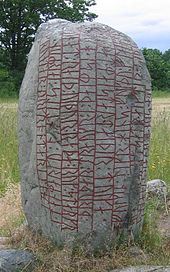Runestone from Karlevi
The rune stone from Karlevi or Karlevistein (Oil 1) is a rune stone on Runsbäcksvägen in Färjestaden , on the Swedish island of Öland . The stone was erected around 1000 AD for a presumably Danish warrior and is part of a grave complex comprising two burial mounds . The inscription is of particular philological importance in Medieval studies , as it is the only runic record of a skald strophe in the Dróttkvætt measure to date.
inscription
The inscription of the Karlevistein, written in a Danish variant of the younger Futhark , consists of three parts: a prose part, the Dróttkvætt stanza and another inscription on the reverse.
Prose part
The prose section starts in the middle of the stone and goes up and down to the right. It says that the stone was erected in memory of a warrior named Sibbe. The stone probably originally stood at the foot of a burial mound , which is confirmed by the Dróttkvætt verse. The full text reads (translated to Düwel ):
“This stone is set after Sibbe, [the] excellent (good) son of Foldar. And his warband put [these] dead [memories] on the island. "
Dróttkvætt stanza
The stanza also begins in the lower center of the inscription but runs to the left. In the following text all rhymes are marked in bold and inner rhymes in red:
| Old West Norse transcription | Verbatim translation |
|---|---|
|
F olg inn liggr hinn's f ylg ðu |
Hidden lies, which followed |
The text doesn't seem to make much sense. The poet uses a complicated imagery with the so-called Kenningar , and the Dróttkvætt (Hofton) as a meter. This meter is particularly difficult because the poet has to put a few stab and inner rhymes into each line without exceeding the limit of exactly six syllables per line.
In today's language it should sound something like this: “The warrior, who was followed by the greatest deeds - most know that - lies hidden in this hill. No strong and righteous warrior will rule over a country in Denmark. ”In both cases, warrior refers to the buried Sibbe.
Meaning of the two Kenningar
dolga þruðar draugr
- dolga means "enmity" or "fight"
- þruð Thrud is the name of Thor's daughter , the name translates as "strength"
- draugr means either “ghost” or “tree”, this word was often used as a kenning for warriors, as warriors should stand as firm as a tree in battle
Composed as the tree of the Thrud of Battles , this kenning is a paraphrase for a warrior, in this case Sibbe.
Endils jǫrmungrundar reið-Viðurr
- Endil is a Sea King, he will introduce in the Nafnaþulur the Prose Edda called
- jǫrmungrund means "huge ground"
- reið means "carriage" or "ride"
- Viðurr is a name of Odin , translated the "slayer"
Taken together, Endil's enormous ground is a paraphrase for the sea, in connection with the sea the chariot becomes a ship, and the ship-warrior is a paraphrase for Sibbe.
back
On the back there is part III of the inscription, consisting of Latin letters in capitals, which could not be interpreted satisfactorily. They are accompanied by two word separators - a cross and a stylized hammer symbol (see. Thor Hammer ), which indicates the transition from paganism to Christianity, in which the stone is also dated.
literature
- Edith Marold : Karlevi: runic studies. In: Reallexikon der Germanischen Altertumskunde (RGA). 2nd Edition. Volume 16, Walter de Gruyter, Berlin / New York 2000, ISBN 3-11-016782-4 , pp. 275-280.
- Klaus Düwel : Runic lore. Stuttgart, Weimar: Metzler, 4th edition 2008. ISBN 978-3-476-14072-2 .
Web links
- Runestone from Karlevi - entry in the database "Fornsök" des Riksantikvarieämbetet (Swedish)
Coordinates: 56 ° 36 ′ 26 ″ N , 16 ° 26 ′ 25 ″ E

